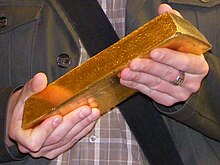Standard Gold Bar Weight & Sizes Guide
Summary
- The LBMA sets the standard for gold bar weight and sizes, with the most common size being 400 troy ounces and a minimum fineness of 99.5% pure gold.
- Standard gold bars have a uniform shape and size, with markings such as a unique serial number and weight in troy ounces for authenticity and value verification.
- The evolution of gold bar sizes has gone from various shapes and sizes in ancient times to standardized weights and internationally recognized sizes in the modern era.
- The Good Delivery System ensures that gold bars meet specific weight and size requirements for global market use, with organizations like the LBMA overseeing these standards. Casting and minting are the two main production processes for gold bars.
Welcome to the ultimate guide on Standard Gold Bar Weight & Sizes. In this informative article, we delve into the fascinating world of gold bars, exploring their various weights and sizes that have become the benchmarks of precious metal trading. Join us as we uncover the essential knowledge behind these gleaming treasures.

LBMA Gold Specifications and Purity
The LBMA sets the standard for gold bar weight and sizes to ensure quality and authenticity. The most common size is 400 troy ounces, but smaller sizes are also available. Gold bars must have a minimum fineness of 995.0 parts per thousand, or 99.5% pure gold, according to LBMA requirements. This ensures high-quality gold for investors. Considering weight and purity is important when developing an investment strategy, and LBMA standards provide confidence in the gold market.
Appearance and Markings of Standard Bars

The appearance and markings of standard gold bars are important aspects to consider when investing in precious metals. These bars typically have a uniform shape and size, with dimensions conforming to industry standards set by organizations such as the London Bullion Market Association. They are often stamped with a unique serial number for identification purposes. Additionally, standard bars may feature specific markings denoting their weight in troy ounces, which is the standard unit of measurement for precious metals. These markings are essential for ensuring the authenticity and value of the bar.
When purchasing gold bars, it is crucial to verify these appearance and markings to ensure you are investing in a trusted and reliable product.

Evolution and Variations in Bar Sizes

| Evolution | Variations in Bar Sizes |
|---|---|
| 1. Ancient Times | Various shapes and sizes depending on the civilization and region |
| 2. Byzantine Empire | Uniform square-shaped bars |
| 3. Renaissance | Rectangular bars with standardized weights |
| 4. Modern Era | Internationally recognized bar sizes and weights |
The Good Delivery System
The Good Delivery System ensures that gold bars meet specific weight and size requirements, making them suitable for use in global markets. Standard gold bar weights typically range from 1 kilogram to 400 troy ounces. These bars are cast in a specific mold and undergo a metallurgical assay to ensure purity and quality. Each bar is stamped with a unique serial number, which helps track its authenticity and provenance.
The Good Delivery System is overseen by organizations such as the London Bullion Market Association, which sets the standards for gold bars. Adhering to these standards is crucial for investors looking to diversify their portfolios with gold as a reliable investment.
Production Processes: Casting and Minting
Casting and minting are the two main ways to make gold bars. Casting melts gold and pours it into a mold, allowing for customization. Minting presses refined gold into a specific shape, ensuring uniformity. Both processes undergo testing for purity. Standard gold bar sizes vary globally, with popular options being 1 kilogram and 10 tola bars.
Gold IRA: Should You Open One To Save For Retirement?


